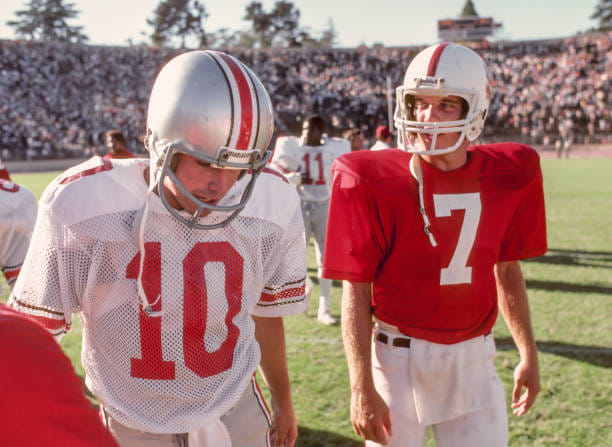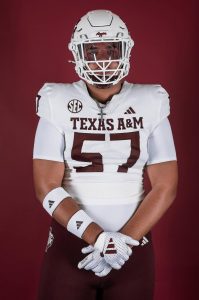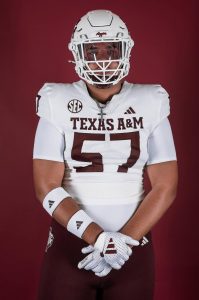Ohio State’s Art Schlichter and Stanford’s John Elway share a moment of mutual respect after their legendary quarterback duel on September 26, 1981, at Stanford Stadium.

PALO ALTO, CA - SEPTEMBER 26: Quarterbacks Art Schlichter #10 of the Ohio State Buckeyes and John Elway #7 of the Stanford Cardinal interact following an NCAA football game between Stanford and Ohio State played on September 26, 1981 at Stanford Stadium in Palo Alto, California. (Photo by David Madison/Getty Images)
On that crisp California afternoon, two of college football’s brightest stars met in a game that would transcend the scoreboard and live on in the lore of the sport. The matchup between the Buckeyes and the Cardinal was more than just a clash of powerhouse programs—it was a convergence of two elite quarterbacks destined for the NFL, each carrying the weight of expectation, legacy, and the eyes of the nation upon them. What unfolded that day wasn’t just a game. It was a moment in history.
Art Schlichter, wearing #10, was already a household name in Columbus and beyond. The senior quarterback was the face of the Ohio State Buckeyes, a program steeped in tradition, pressure, and championship aspirations. Schlichter had come into the 1981 season with Heisman hopes and the confidence that comes from leading a storied Big Ten powerhouse. With his rocket arm and cerebral command of the offense, he represented the kind of quarterback Ohio State fans had longed for—a field general with both swagger and substance.
Across the field stood John Elway, the golden-armed junior in cardinal and white, who had already begun building a reputation as a generational talent. His father, Jack Elway, was a coach, and the younger Elway had grown up with football in his blood. Stanford’s program wasn’t Ohio State’s equal in terms of tradition or national clout, but on this particular day, none of that mattered. Elway had the tools to change any game—and any narrative—with one flick of his wrist. Even then, scouts and analysts knew he was special.
Stanford Stadium was electric. The 1981 game had been circled on calendars for months. It was a measuring stick for both teams, but even more, it was a quarterback showcase. The first quarter opened with both offenses feeling each other out. Schlichter led a methodical Buckeyes drive, mixing short passes with runs to set the tempo. Elway answered with his trademark zip, hitting tight windows and testing the OSU secondary. The game had the rhythm of a heavyweight bout, with neither team willing to back down.
By halftime, fans were treated to a masterclass in quarterback play. Schlichter had thrown for over 150 yards and a touchdown, while Elway dazzled with his ability to escape pressure, extend plays, and deliver downfield strikes. The Cardinal led narrowly, but the game remained wide open. Every possession felt like it could tip the balance. Every throw from Schlichter or Elway felt like a glimpse into the future.
As the second half unfolded, the tension escalated. Ohio State’s defense, known for its discipline, struggled to contain Elway’s improvisational magic. On one memorable play, Elway evaded three pass rushers, rolled to his right, and launched a 40-yard strike across his body to a receiver streaking toward the sideline. It was the kind of throw that made jaws drop, even among opposing fans.
Schlichter, not to be outdone, responded with grit and poise. He orchestrated a late third-quarter drive that culminated in a touchdown pass over the middle, threading the needle between two defenders. The game became a chess match between two minds that seemed always one step ahead. And for every punch thrown, there was a counterpunch. The quarterbacks were elevating not only their teams but each other’s performances.
With under five minutes to go in the fourth quarter, Stanford held a slim lead. Ohio State had the ball and a chance to steal the win on the road. Schlichter dropped back, scanned the field, and delivered a dart to his receiver, converting a critical third down. The Buckeyes inched toward the red zone. But Stanford’s defense stiffened just in time, forcing a turnover on downs that all but sealed the victory.
When the clock hit zero, the Cardinal faithful erupted. Stanford had pulled off a significant upset over a top-tier Big Ten opponent, and Elway was the hero. But the postgame image that remains etched in memory wasn’t about celebration or defeat—it was about respect. As players from both teams shook hands, John Elway and Art Schlichter found each other near midfield. They shook hands, embraced briefly, and exchanged a few words. No cameras captured what they said. But the gesture spoke volumes.
In that fleeting moment, two competitors recognized greatness in each other. Two young men, both chasing NFL dreams, both navigating the pressures of college stardom, shared a bond that only a few ever truly understand. It was the kind of moment that cuts through rivalry, cuts through the noise, and reminds everyone why we watch in the first place. For talent. For passion. For mutual respect.
What made the game so memorable wasn’t just the statistics, though they were impressive. Schlichter threw for over 280 yards and two touchdowns. Elway surpassed 300 yards and added two of his own. But the true legacy of that game rests in how it showcased the heart of competition. It reminded everyone watching that college football, at its best, is about the clash of styles, the roar of the crowd, the risk of failure, and the thrill of possibility.
The 1981 season would take both men down very different paths. Schlichter would be selected fourth overall in the 1982 NFL Draft by the Baltimore Colts. His pro career, however, was plagued by off-the-field issues, including a well-documented gambling addiction that derailed what could have been a long and successful career. Despite the talent he had shown at Ohio State, Schlichter’s legacy would become a cautionary tale of potential unfulfilled.
Elway, meanwhile, would go on to become one of the greatest quarterbacks in NFL history. Drafted first overall in the 1983 draft by the Baltimore Colts (the same franchise that drafted Schlichter), Elway famously refused to play for them and was traded to the Denver Broncos. There, he built a Hall of Fame career, leading the Broncos to five Super Bowl appearances and winning two before retiring on top. His name remains synonymous with elite quarterback play, leadership, and late-game heroics.
But for those who watched them in college, particularly on that September day in 1981, there was no doubt that both Schlichter and Elway had the tools to be special. They didn’t just play the quarterback position. They owned it. Their duel at Stanford Stadium wasn’t merely a highlight of the season—it was a snapshot of what makes college football timeless.
Years later, fans still talk about the game. About the throws. The tension. The sense that history was unfolding in real time. And especially about that handshake. That simple act of sportsmanship has become part of the game’s enduring narrative. It symbolizes everything right about competition. You fight. You lead. You give your all. And at the end, you recognize the effort of the one who stood across from you.
For Elway, that game was a major stepping stone on his path to immortality. For Schlichter, it was one of his finest hours in a career that would later be defined by regret. But for both, September 26, 1981, was a defining chapter.
Looking back now, over four decades later, the game has taken on an even deeper meaning. It reminds us that greatness is sometimes fleeting and that the journey is never guaranteed. It also reminds us that moments—just a handshake, a word, a glance—can outlast the box score and live on in the hearts of those who witnessed them.
So while the final score may fade, and the stadium may have changed, the legacy of Elway vs. Schlichter remains—a story of brilliance, respect, and one unforgettable Saturday in Palo Alto.




